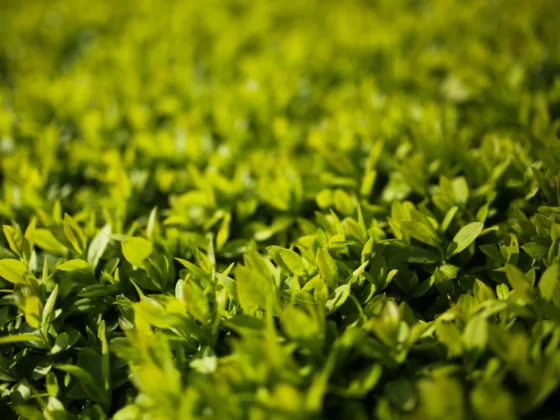Table of Contents Show
Lawn Mowing Tips for Healthy Grass, Determining the proper way to mow the lawn ensures that the turf grass remains healthy and withstands attacks from opportunistic weeds and pests. Make mistakes in this area, mow the lawn incorrectly, and the results may cost you plenty in curb appeal.

Lawn Mowing Tips: The Proper Way to Mow the Lawn
Simple Lawn Care
Lawn mowing sounds like a simple enough task. After all, you have seen countless youngsters do it as part of their weekly chores. As a homeowner concerned with maintaining and preserving curb appeal, you should wonder if they have been taught the proper way to mow in the first place.
Moreover, does their expertise represent a skill that is transferable to your specific turf grass’ needs? The answer – perhaps surprisingly – is a resounding ‘no.’ There is more to lawn mowing than meets the eye.
How Do You Mow the Lawn?
Turn over your lawnmower and locate the cutting blade. Note that there are different height settings. These settings enable the landscaper to control the height that the grass will be after it is cut.
As a general rule of thumb, grass – notably Kentucky bluegrass, perennial ryegrass, and fine fescues — should be mowed at a height of 2.0 to 2.5 inches during the spring and fall months.
An exception is the tall fescue, which should always be mowed at a height of 2.5 to 3.0 inches, no matter the season. A clover lawn also features different mowing requirements.
In the summer, when water is restricted and frequent use adds stress to the turf grass, allowing the grass blades to grow taller. Generally speaking, cut the grass to a height of 2.5 to 3.0 inches for all varieties.
Size matters when it comes to lawn height. The Ohio State University Extension explains that taller grass inhibits weeds from establishing themselves in the lawn area.
As the grass blades shade the soil, germinating weed seeds lack the sunlight for photosynthesis and therefore cannot produce the sugars needed for tall plant growth and aggressive root spread.
In addition, taller grass has deeper roots than scalped grass. This not only enables the grass to withstand use and traffic, but it also enables the plants to find moisture from deeper within the soil, when shallower root systems wither for lack of water.
It is a good idea to change the direction in which the lawn is mowed at every other occurrence. This protects some areas of the grass from getting scalped, especially when the soil features irregular or slight elevations in some areas.
It also eliminates the problem of stray blades that get continuously pushed down when mowing only takes place in the same direction.
Read Also:
How Often Do You Have to Mow the Lawn?
Frequency is determined by the amount of grass blade length that must be removed. It is ill-advised to wait so long in between mowings that more than one-third of the grass gets cut. During summer growth periods, this rule of thumb necessitates sometimes weekly or even twice-a-week lawn mowing.
For example: the homeowner with tall fescue knows to keep the grass at a height of 2.5 inches. This means that the lawn must be mowed when the grass gets to be 3.5 inches in height.
Double-cutting – the process of mowing the lawn once in one direction and then again in another – should only be undertaken if the grass has grown exceptionally tall. In this case, it is a good idea to set the blade height to the tallest setting and mow the grass once. For the second pass, reset the height to the setting appropriate for the grass type and season and then mow again.
Is it Good to Cut the Grass Before it Rains?
Determining when to mow the lawn takes into consideration the climate and other environmental factors.
What is the Best Time to Mow the Lawn?
- In the afternoon, when the sun is going down and will not burn the freshly cut grass
- About a week after applying lawn chemicals
- When the grass is reasonably dry and not weighed down after recent rains or watering
When to Not Mow the Lawn
- Right after a downpour that leaves the grass bent down and likely to clump
- On the day of a major event when the turf grass experiences a lot of foot traffic
- Just before applying lawn chemicals unless doing so is indicated on the product instructions
- When the blades of the electric lawn mower or push reel mower have become dull
Read Also:
Is it Safe to Mow the Lawn with Your Toddler?
Involving young children in this aspect of lawn care is not safe. Remember that there is not only the cutting blade that presents a very real danger of injury, but there is also the dust and debris that may be loosened by the blade and which may turn into small projectiles that are sent in all directions.
A toddler may be harmed by a small rock that hits her eyes or soft skin. Teach children about a way to mow the lawn properly when they are old enough to understand the need to wear safety goggles and dress properly for the task – and when they commit to doing so at all times.
It is evident that there is a lot more to lawn mowing than meets the eye. Hobbyists and landscapers will do well to carefully educate themselves on the needs of the particular grass varieties with which they are dealing to ensure years of vigorous growth.
Guide to Buying and Using Electric Lawn Mowers
Electric lawn mowers offer an environmentally friendly choice for the most common landscape maintenance task: cutting grass. Find out how to go gas-free and how the mowing experience may differ when compared to the gas-powered models.
- Comparison: What are the Best Electric Lawn Mowers?
- How to Mow a Lawn Fast and Professionally with an Electric Mower
- Lawn Mowing Tips for Healthy Grass, The Proper Way to Mow the Lawn










